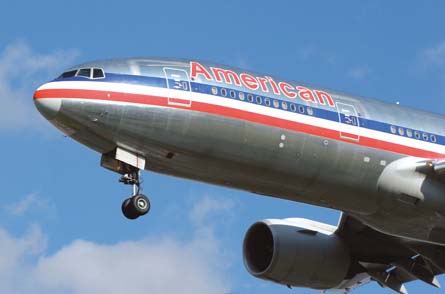By Guy Norris in Los Angeles
Software simulations on leased testbed prove to be effective validating tool and reveal unexpected problems
Boeing has begun initial flight tests of the trailing-edge variable camber (TEVC) system in development for the 787, using the concept validation and risk-reduction (CV/RR) 777-200ER testbed.
The tests include simulation of the 787's drooped ailerons, but not any mechanical modification to the baseline 777, and are restricted to the CV/RR's adapted flight-control system. "We can validate these concepts by varying the trailing-edge surfaces," says 787 systems chief engineer Mike Sinnett.
|
|
|---|
| A 777-200ER leased from American is being used for the 787 tests |
The tests, being flown by a 777-200ER (N780AN) leased from American Airlines for 10 months, include evaluation of the modified software to simulate the increased wing twist angle of the 787, which is designed to shift lift distribution inboard, helping to reduce overall structural weight and improve efficiency. It is unclear how the wing twist is being simulated, and Boeing declines to offer details.
Boeing hopes the TEVC will reduce cruise drag, save the equivalent of 340-450kg (750-1,000lb), and take advantage of the all-new wing and flight-control surface as well as the three-axis flight-control laws being developed for the 787. The automatic system, which will be the first practical commercial application of an in-flight variable camber concept, will operate by deflecting the trailing-edge flaps in 0.5° increments while in cruise.
Although the 777 CV/RR tests are effectively mimicking the effect of the trailing-edge movement, the motion on the actual 787 surfaces will be driven by an electric power drive unit integrated with the torque-tube-driven flap actuation mechanism. Although the TEVC control unit will add around 36kg, Sinnett says the predicted "0.4-point count in drag reduction" will convert into roughly 450kg of saved weight. The system will be capable of moving the trailing edge through a 3° arc, with the trailing edge being set up and down by as much as 1.5° either side of a neutral setting position.
Tests using the 777 have shown the value of the testbed by uncovering issues with initial versions of the 787 flight-control software, says Sinnett. "We found problems we hadn't expected, and some we did expect," he adds. "It's been a great tool for validating the concept, and we're going into the flight-test programme with the right set of control laws."
The 777-200ER was leased to validate and test the software for the enhanced 787 flight-control system before it is flight tested on the real aircraft. The 777, which has since been used to test non-specific 787 FCS work such as the variable camber system and for revised load distribution for the 777 Freighter, will be returned towards the end of the year.
Source: Flight International
























